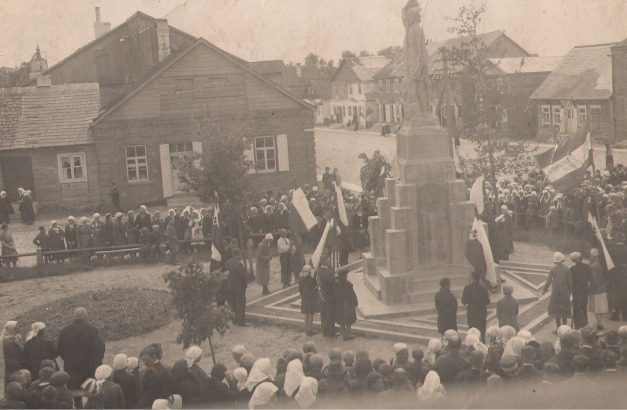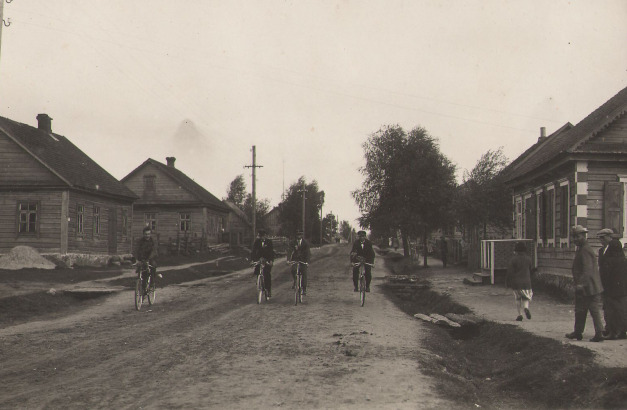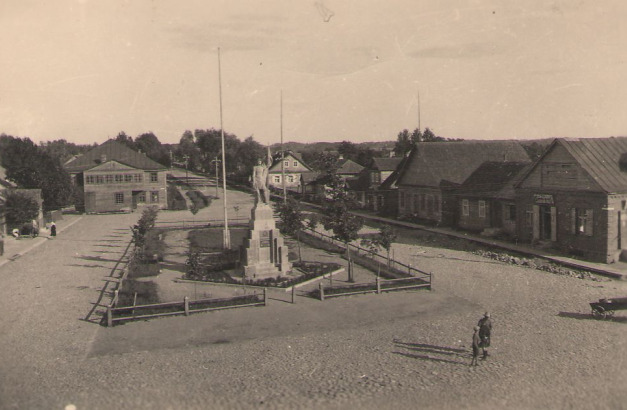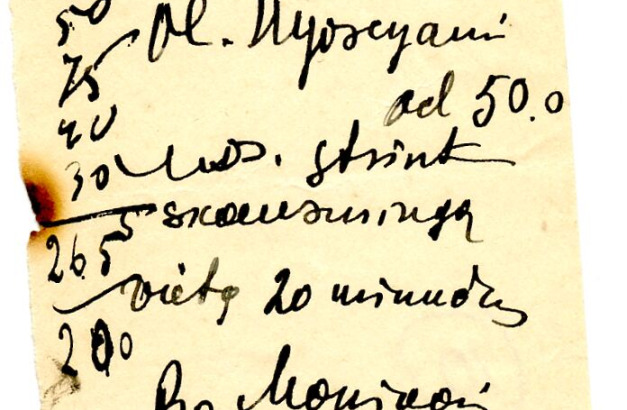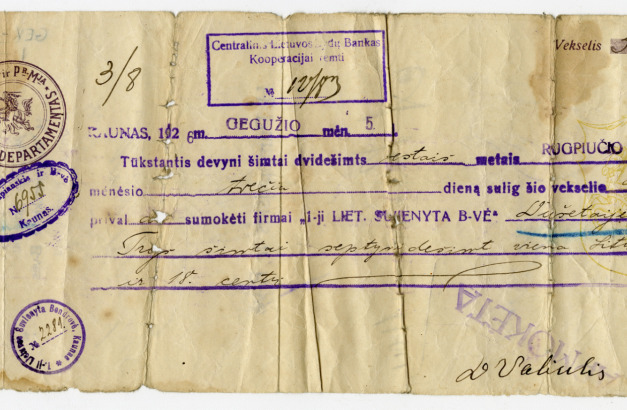Dusetų miestelis iš Radvilų dvarui priklausančio kaimo išaugo XVI a. pradžioje. 1530 m. Jono Radvilos fundacijos rašte nurodoma, kad Dusetose jau buvo susiformavęs miestelis su turgaus aikštė, karčemomis, amatinkais ir čia gyvenančiais žydais. Ankstyvas žydų bendruomenės įsikūrimas istorikams kelia daug klausimų, kadangi XVII a. šaltiniuose Dusetose gyvenančių žydų nebesutinkama.
Nenutrūkstantis žydų bendruomenės gyvenimas Dusetose prasidėjo XVIII a., pasibaigus Šiaurės karui. 1775 m. duomenimis Dusetose ir apylinkėse gyveno 86 žydų šeimos, tiesa, dalis jų gyveno Dusetų apylinkėse esančiose karčemose. XIX a. eigoje smarkiai išaugus miestelyje gyvenančių žydų skaičiui, miestelį galime vadinti tipiniu štetlu. 1897 m. iš visų 1278 Dusetų gyventojų – net 1158 buvo žydai. Miestelyje dažnai siautėjo gaisrai, dėl kurių įprastai miestelėnai kaltindavo žydus. Po vieno iš miestą nusiaubusių gaisrų, 1905 m. Dusetose įvyko pogromas, kurio metu buvo nužudytas vienas ir sužeisti keli žydai. XX a. pirmaisiais dešimtmečiais suaktyvėjo vietos žydų emigracija į tuometinę Pietų Afrikos sąjungą, JAV ir bei Palestiną, tad 1923 m. Dusetose gyveno 704 žydai, sudarę apie 60 proc. visų miestelio gyventojų, dauguma jų gyveno dabartinėse Vilniaus ir Vytauto gatvėse.
Dusetose stovėjo dvi medinės sinagogos. Viena priklausė mitnagedams, kurie sudarė daugumą štetlo gyventojų, kita - chasidams, buvusi vakarinėje miestelio dalyje ant Sartų ežero kranto. Tuo tarpu mitnagedų sinagoga stovėjo pačiame miestelio centre besiribodama su pagrindine miestelio aikšte. Nei viena sinagoga neišliko.. Mitnagedų sinagoga buvo nugriauta XX a. 7 deš. pradžioje, o jos vietoje pastatytas kino teatras „Sartai“.
Štetle būta visko: ir pasiturinčių, ir viduriniosios klasės žydų, taip pat netrūko elgetų ir vargšų. Vietos žydų veiklos buvo orientuotos į netoliese esantį Daugpilio miestą. Būtent ten pirkliai ir amatininkai realizuodavo dalį savo turimos produkcijos ir žaliavų. XIX a. paskutiniais dešimtmečiais Dusetose apie 150 žydų vertėsi prekyba, 70 amatais, o beveik visos miestelio parduotuvės priklausė žydams. Tarpukariu atsiradusios sienos nors ir sudavė reikšmingą smūgį Dusetų žydų verslams, tačiau jų nesunaikino. Vietos žydams priklausė keli malūnai (vienas iš jų tiekė elektrą) ir dirbtuvės, kepykla, įvairių prekių parduotuvės bei restoranas. Be kita ko, tarpukariu vietos gyventojų sveikata rūpinosi gydytojas Dovydas Epšteinas ir jo žmona odontologė Sara Epšteinienė. 1924 m. įkurtas Žydų liaudies bankas vaidino svarbų vaidmenį miesto ekonominiame gyvenime.
Beveik visi žydų vaikai lankė chederius, Lietuvos nepriklausomybės metais miestelyje veikė Tarbut pradinė mokykla su dėstomąja hebrajų k., žydų biblioteka ir dramos būrelis. Vakarais vyko hebrajų kalbos kursai. Šnekamoji kalba buvo jidiš, nors nemažai štetlo žydų, taip pat buvo išmokę hebrajų kalbą. Dusetų žydų tarpe itin didelio populiarumo sulaukė sionistinės idėjos, tad nemaža dalis jaunimo priklausė įvairioms sionistinėms organizacijoms. Sporto klubui „Makabi“ priklausė 50 narių. 1940 m. Sovietų Sąjungai okupavus Lietuvą, Tarbut hebrajų mokykla tapo jidiš mokykla. Visos sionistinės jaunimo organizacijos buvo išvaikytos ir hebrajų knygos vietos bibliotekoje konfiskuotos.
Holokausto išvakarėse Dusetose gyveno 80 šeimų. 1941 m. Vokietijos armijai besiartinant prie Lietuvos, 23 Dusetų žydai sugebėjo pabėgti kartu su besitraukiančia Sovietų armija. Likę žydai pirmosiomis dienomis buvo suvaryti į kelis namus, šalia jų esančias daržines bei sandėlius. 1941 m. rugpjūčio 26 d. Krakynės miške, kartu su kitų aplinkinių vietovių žydų gyventojais, buvo nužudyti visi Dusetų žydai.
DUSETOS (Dusyat, דוסיאַט)
The town of Dusetai grew out of a village belonging to the Radvila manor at the beginning of the 16th century. According to the foundation letter of John Radvila in 1530, Dusetai had already developed into a town with a market square, taverns, craftsmen and Jews living there. The early settlement of the Jewish community raises many questions for historians, as the 17th century sources do not mention any Jews living in Dusetos.
The continuous life of the Jewish community in Dusetos began in the 18th century, after the end of the Northern War. According to the data of 1775, 86 Jewish families lived in Dusetos and its surroundings, although some of them lived in the inns in the vicinity of Dusetos. As the number of Jews living in Dusetse grew considerably during the 19th century, the town can be called a typical shtetl. In 1897, as many as 1158 out of 1278 inhabitants of Dusetai were Jews. The town was often plagued by fires, which the townspeople usually blamed on the Jews. After one of the fires that devastated the town, a pogrom took place in Dusetos in 1905, during which one Jew was killed and several others injured. In the first decades of the 20th century, the emigration of local Jews to the then Union of South Africa, the USA and Palestine intensified, so that in 1923, 704 Jews lived in Dusetos, making up about 60% of the town's total population, the majority of whom lived in the present-day streets of Vilniaus and Vytautas.
There were two wooden synagogues in Dusetos. One belonged to the Mitnagedim, who made up the majority of the shtetl's inhabitants, and the other to the Hasidim, located in the western part of the town on the shore of Lake Sartai. The synagogue of the Mitnagdim stood in the very centre of the town, adjacent to the main square of the town. Neither synagogue has survived... The Mitnagedi synagogue was demolished in the 7th century. In the beginning of the 7th century, the Sartai Cinema was built in its place.
The shtetl was full of wealthy and middle-class Jews, as well as beggars and the poor. Local Jewish activities were focused on the nearby city of Daugavpils. It was there that merchants and craftsmen sold some of their products and raw materials. In the last decades of the 19th century, about 150 Jews were engaged in trade and 70 in crafts in Duset, and almost all the shops in the town were owned by Jews. The walls between the wars, although they dealt a significant blow to Jewish businesses in Duset, did not destroy them. Local Jews owned several mills (one of which supplied electricity) and workshops, a bakery, a variety of shops and a restaurant. In the interwar period, the health of the local population was looked after by a doctor, Dovydas Epšteinas, and his wife, dentist Sara Epšteinienė. The Jewish People's Bank, founded in 1924, played an important role in the economic life of the town.
Almost all Jewish children attended cheders, and during the years of Lithuanian independence the town had a Tarbut primary school with Hebrew classes, a Jewish library and a drama group. In the evenings, Hebrew language courses were held. The spoken language was Yiddish, although many of the shtetl's Jews had also learned Hebrew. Zionist ideas were very popular among the Jews of Duset, and many young people belonged to various Zionist organisations. When the Soviet Union occupied Lithuania in 1940, the Tarbut Hebrew School became a Yiddish school. All Zionist youth organisations were dispersed and Hebrew books in the local library were confiscated.
On the eve of the Holocaust, 80 families lived in Dusetos. In 1941, as the German army approached Lithuania, 23 Jews from Duset managed to escape with the retreating Soviet army. The remaining Jews were rounded up in the early days into a few houses and the barns and warehouses next to them. 26 August 1941. On 26 August 26th, all the Jews of Dusetai were murdered in the Krakynė forest, together with the Jewish population of the surrounding area.
